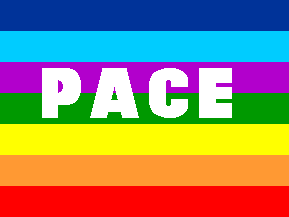
Old version
by Marcus Schm÷ger, 2 August 2002

Last modified: 2007-09-15 by dov gutterman
Keywords: pacifism | pace | italy | peace | rainbow flag |
Links: FOTW homepage |
search |
disclaimer and copyright |
write us |
mirrors

Old version
by Marcus Schm÷ger, 2 August 2002
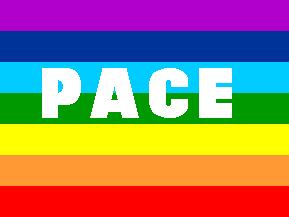
New version
by Marcus Schm÷ger, 2 August 2002
See also:
You might be interested in the peace campaign that has been
ongoing in Italy since early autumn. "Peace from every
balcony" is an effort to get people to show their opposition
to war in general and specifically Italian partecipation in the
US military campaign against Iraq. see <www.bandieredipace.org>.
It's only in Italian but basically the idea is to fill the cities
of Italy with the rainbow flag.
As far as I know, the version with the white stripe was the
original from the early 1990's. You don't see this much anymore.
You can see the current version above.
David Macdonald, 21 January 2003
The version most commonly used has only seven row. The
"absent" row is the white one. It is often called the
"bandiera arcobaleno" (rainbow flag).
Sergio Frosini, 26 Febuary 2003
I've seen a lot of Italian pacifist flags watching TV (e.g.
the great March for Peace in Rome) or just driving around
Florence. Some of these flags have a white stripe above: I think
they are the oldest ones: the new flags sold by municipalities
and NGO are identical to the one above. However, there are a lot
of variations: apart from the "latest model": a very
common pacifist flag is similar to the Previous
Flag with the white upper stripe, but it often lacks the
white stripe and has got (usually) a thicker lettering (like that
of the above flag). These flags are now used by some 15% of
Italian population, to show their opposition to the war against
Iraq.
There have been also polemics about the similarity of this flag
with the rainbow-"Gay Pride" one. Some Traditionalist
Catholics blame that they are almost identical and good Catholics
should not use it. An Italian gay leader, Franco Grillini, has
said that the pacifist flag was created before the
"rainbow-"Gay Pride" one, as it was first used in
1961 by Aldo Capitini, leader of the Italian non-violent
movement.
Paolo Montanelli, 26 Febuary 2003
I am involved in the campaign "Peace from every
balcony" and personally distributed some hundreds of rainbow
flags. In almost all the cities and towns in Italy there are
peace flags fluttering from the balconies. It is a very popular
campaign: for instance, in the city I live (Pioltello, near
Milan) there are 15.000 families and 2.000 peace flags ! It is
estimated that in the whole Italy there are at least 500.000
peace flags at the balconies. It is the first time in the Italian
history that so many flags are exposed by private citizens.
I also inform you that there are TWO patterns of the Italian
pacifist rainbow flag. One pattern is: blue,azure, violet, green,
yellow, orange, red; PACE is over violet and green. The other
pattern is: violet, blue, azure, green, yellow, orange, red. The
writing PACE covers azure and green. The second one is more
common and also is more like a true rainbow. The other patterns
shown in your page (as Previous Flags) are not
currently used.
Giuseppe Bottasini, 28 March 2003
At peace demostrations this week in Munich (24/27/29 March), I
noted a PACE flag as a "vexillum" (see <www.smev.de/2403>),
and a PACE flag as a over-skirt (see <www.smev.de/2903>).
Marcus Schm÷ger, 31 March 2003
This morning, driving around my town near Florence, I've seen
some flags matching the pattern seen at the lower flag above,
maybe with a slightly darker violet and a lighter deep blue as
the two upper colours. So, it cannot be considered incorrect,
even if the pattern in the upper flag above which can be seen at
<italy.peacelink.org>
is more frequent.
Paolo Montanelli, 2 May 2003
The newer version, as of years 2001-2002 - The description of
the flag is as follows: seven horizontal stripes of identical
size, one for each of the seven colours of the rainbow, namely
(from top to bottom) purple, blue, cyan, green, yellow, orange
and red. The word "PACE" (peace) is spelt in bold white
capital letters, over the third and fourth stripes. Some early
versions of the flag had the first and third stripes (i.e. purple
and cyan) reversed, so that the white letters would make a
sharper contrast, but this was abandoned in favour of the regular
sequence of rainbow colours. The flag is only produced in the
Italian version; seldom, specimens with the English word
"PEACE" are seen. The flag is currently flown all over
Italy and Switzerland, and has become rather popular in most
other countries too. The alleged plagiarism initially claimed by
the Gay Movement, due to the similarity of their own flag, is
only apparent; the peace flag has seven stripes, whereas the
other one has six, in reversed order (from the top: red, orange,
yellow, green, blue, purple; cyan is missing), and it does not
have a text. The standard size of the present peace flag is 130 x
100 cm.
Andrea Pollett, 3 June 2004
I located the original "Italian pacifist flag" used
by the non-violent leader Aldo Capitini in the March for Peace in
1961 at <www.comitatopace.it>.
The text is in Italian: here is an English version:
"The first Peace flag is now in Collevalenza, near Todi
(town in Central Italy) kept by dr. Lanfranco Mencaroni, a
friend, jail-fellow and collaborator of the pacifist philosopher
Aldo Capitini, who invented the March for Peace Perugia-Assisi
(the town where St. Francis lived).
The flag was first shown during the first March for Peace,
September 24, 1961. It was inspired by the flag of Anglo-Saxon
pacifists who marched in Aldermaston for an anti-nuclear protest,
led by Bertrand Russell. Mr. Capitini asked some housewives from
Perugia, who were friends of him, to sew with all possible speed
some coloured stripes to form a flag to be shown during the
march.
In the story of the Flood, God puts the rainbow as a seal of his
alliance with humans and nature, promising that will never be
another Flood. So the rainbow became the symbol of peace between
the Earth and Heaven,and, in consequence of that, among all
mankind.
The colours of the rainbow are also used as sign of "unity
in difference" for their physical characteristic of becoming
white if they are wheeled quickly.
The same definition of "Peace symbol" given to the flag
can date back to the Greek word "syn-ballo" which means
"to put together", like the rainbow which puts together
everything and everybody.
Moreover, these colours (only five) can be found also in
"the flag of the races", used by the Civil Rights
society founded by the democratic Afro-American leader Jesse
Jackson.
The Peace flag was used widely in the 80's during the Peace
marches and all Italian demonstrations, as well as in peace
initiatives by Italian volunteers abroad (in Sarajevo, in Iraq,
in Kosovo, in the Democratic Republic of Congo).
Since September 2002, the Peace flag became the symbol of the
campaign "Pace da tutti i balconi" (= Peace from every
balcony) which gained great success in Italy: hundreds of
thousands people show the flag from balconies and window-sills to
say "no!" to the conception of preventive war and to
war in Iraq".
Paolo Montanelli, 1 March 2003
1)![[8 color Pacifist flag in Italy]](../images/i/it}pace.gif)
by Antˇnio Martins, 14 May 1999
It's a very used flag in Italy, mainly fluttered by
left-oriented and/or catholic pacifist movements. It has eight
horizontal strips, from to bottom: white, dark blue, blue, azure,
green, yellow, orange and red. Over the two central strips
there's the white writing PACE ("peace" in
Italian).
Giuseppe Bottasini
2)
by Antˇnio Martins, 27 September 2001
I have a photo of this flag hoisted in demonstration calling
for peace in Butembu (Kivu, Democratic republic of Congo). Flag
in photo is SIXstriped (and not eighstriped) starting above with
the color purple, and following (to below) with blue, light blue,
green, yellow and red (upper white stripe and lower orange
stripe are mising). Letters PACE in white are in the light blue
and green stripes. Is it a simplified version or is it a
different flag?
Jaume OllÚ, 7 July 2001
It seems to be a variation of the same flag -- rainbow flags
often have not fixed number nor order of stripes. If you are
curious about what a flag with italian words is doing in Kongo-Z,
I'd bet it related to the Combonian missionaries, an italian
order.
Antˇnio Martins, 27 September 2001
3) 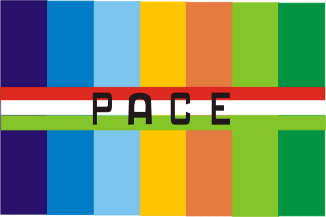
by Jaume OllÚ, 27 March 2005
Flag used in the 1960'.
Jaume OllÚ, 27 March 2005
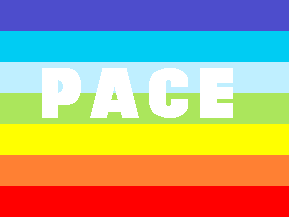
by Marcus Schm÷ger, Tomislav Todorovic and Mladen
Mijatov, 3 June 2005

by Marcus Schm÷ger, Tomislav Todorovic and Mladen
Mijatov, 3 June 2005
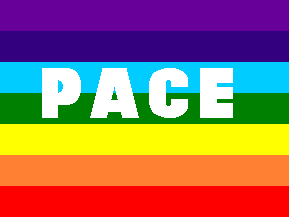
by Marcus Schm÷ger, Tomislav Todorovic and Mladen
Mijatov, 3 June 2005
Issue #708 (published on 2004-07-02) of Croatian magazine
"Globus" (ISSN 0353-9903) contained a long text about
Veronica Berlusconi, wife of current Italian prime minister
Silvio Berlusconi. On page 104, there was a separate sub-article
titled "A Voice Against the Husband" (Croat: "Glas
protiv supruga"), describing how political opinions of Mrs
Berlusconi often differed from those of her husband, especially
about the Italian military presence in Iraq, which she opposed.
As an illustration, there was a photo from some anti-war protests
in Italy (time and place not mentioned, Mrs Berlusconi not shown
there), showing numerous PACE flags, three of which were clearly
visible and could be identified as versions different from the
previously described ones:
The closest to the photographer, in the central left part of the
photo, there was a large flag with the following colour pattern:
dark blue, light blue, very light blue, green, yellow, orange and
red; white word PACE was over very light blue and green (upper
image above). This resembles a bit the original version of the
flag, but omits the top white stripe; also, dark blue is lighter
here and inclines a bit towards the violetblue, light blue is
very similar to Zircon Blue from the flag of Sabah, Malaysia - perhaps inclines a bit
more towards the cyan - and very light blue is a bit darker than
Icicle Blue from the flag of Sabah; green is much lighter and
orange is a bit darker than on the other PACE flags.
On some distance behind the previously described flag, in the top
left part of the photo, there was a flag with the following
colour pattern: dark blue, purple, light blue, green, yellow,
orange and red; white word PACE was over light blue and green
(see second image above). Here, dark blue is a bit darker than on
the previously described flag and does not incline towards the
violetblue, purple is FIAV colour P or very close, while green is
a bit lighter than on the other PACE flags and orange is the same
as on the previously described flag.
Far behind two previously described flags, in the top right
corner of the photo, there was a flag, looking small due to the
distance, but with clearly visible colour pattern: purple, dark
blue, light blue, green, yellow, orange and red; white word PACE
was over light blue and green (see bottom image above). Here,
purple and orange are the same as on the previously described
flag, while dark blue and green are darker than elsewhere.
The colours not mentioned in these descriptions are the same as
on the other PACE flags.
There were many other flags on the photo, but they were either
too distant or not unfurled completely, so they were not clearly
visible. Still, it could be seen that some of them were charged
with word PACE in a typeface different than elsewhere, while the
colour patterns were mostly like those of the three flags
described here.
Tomislav Todorovic, 3 June 2005
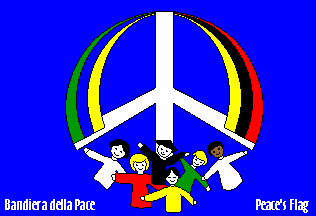
by Antˇnio Martins, 5 April 2005
Another Italian peace flag
can be seen at <www.sistemia.it/pace>.
Dov Gutterman, 4 September 1999
This shows on a blue background a stylized version of the peace-sign consisting the ring around it
of two flag like ribbons (horizontal tribands: yellow - blue -
green on the hoist side, and yellow - black - red on the fly
side), completed by groups of figures representing children from
several ethnic groups at the bottom. On the bottom hoist corner
the lettering "Bandiera della Pace" (italian for
"flag of peace"), and on the bottom fly "Peace's
flag", both in white letters.
Apart from showing the universalness of broken English, this flag
informs us that two out of each five children is blond, that dark
skinned children have though white hand and neck, and that
Chinese racial features include black conical hats.
Antˇnio Martins, 27 September 2001